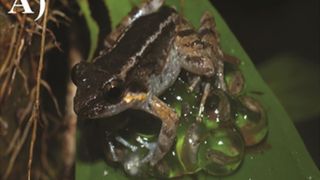World's tiniest fanged frog with males that 'hug' their babies discovered
Researchers found a new species of fanged frog when they noticed clutches of eggs laid on leaves and mossy boulders unusually far above water.

A team of researchers has identified a teeny new frog species that's no bigger than a quarter. But don't let its diminutive size fool you: This one has fangs.
The new species, Limnonectes phyllofolia, which the researchers described in a new study published Dec. 20 in the journal PLOS One, was found in the lush forests of Sulawesi, an Indonesian island renowned for its biodiversity — including fanged frogs.
The frogs use these teeth like weapons to tussle with their competitors for territory to lay their eggs. Researchers think the frogs may also use their fangs to pierce through the protective casings of prey such as insects and crabs. (Technically, the saber-like structures, which are situated in the frogs' lower jaws, are bony protrusions, not teeth.)
The fact that some frogs have teeth may come as a surprise. In fact many frog species have tiny teeth that line the upper jaw — though these are near-invisible in most. However the 70-plus species of the genus Limnonectes are known for the more notable fang-like protrusions on their lower jaws. These fanged amphibians are spread across East and Southeast Asia, and the dense rainforests of Sulawesi are a hotspot, home to 15 of those species. Some of the frogs in the genus are huge, such as the Blyth’s river frog (Limnonectes blythii) which can weigh over 2.2 pounds (1 kilogram). But the genus' newest member, L. phyllofolia, is just 1.2 inches (3 centimeters) long, meaning it's the smallest fanged frog in the world.
Related: These female frogs fake their own deaths to get out of sex
But its minuscule size isn't this frog's only unusual trait. Researchers first discovered the new species when they noticed some strange nesting behavior in the Sulawesi rainforest. They spied unmistakable clusters of frog eggs spread across mossy boulders, fern fronds and the leaves of sapling trees, which surprised them because most frogs lay their delicate eggs in riverbanks and ponds to prevent the gel-like sacs that surround the developing tadpoles from drying out.

What's more, when the researchers hung around to find out which animal these above-ground nesting sites belonged to, they noticed the tiny frogs that returned to their eggs were all male. "Male egg guarding behavior isn't totally unknown across all frogs, but it's rather uncommon," study lead author Jeff Frederick, a postdoctoral researcher at the Field Museum in Chicago, in a statement. Males are the primary caretakers in only one other fanged frog species, L. arathooni, which lays its eggs at ground level in stream banks and ponds.
Sign up for the Live Science daily newsletter now
Get the world’s most fascinating discoveries delivered straight to your inbox.
The unusually doting dads of L. phyllofolia — whose second name means "leaf-nester" — get around the threat of desiccating eggs by seemingly "hugging" their brood, coating the eggs in compounds that are excreted from their skin to keep their progeny moist and ward off bacterial and fungal infection, the researchers said in the statement.
Whether laid on a leaf or a mossy rock, each nest had been positioned about 3 to 6.5 feet (1 to 2 meters) above a body of water. This means that when it comes to hatching time, the tadpoles can conveniently slither out of their eggs and plop directly into the water.
The researchers think this unusual nesting behavior might help explain why the frogs evolved to be so small and have tiny pinprick fangs compared with their relatives' larger teeth. Choosing nest sites above ground and away from other competitors seems to work well enough at protecting the nest from competitors and predators that these frogs don't need a hefty body weight or impressive gnashers to do the job.
The researchers hope that the discovery of L. phyllofolia will provide extra motivation to study these creatures. Of the 15 species in Sulawesi, only five have been formally described, they noted. "Our findings also underscore the importance of conserving these very special tropical habitats," Frederick said. "Learning about animals like these frogs that are found nowhere else on Earth helps make the case for protecting these valuable ecosystems."

Emma Bryce is a London-based freelance journalist who writes primarily about the environment, conservation and climate change. She has written for The Guardian, Wired Magazine, TED Ed, Anthropocene, China Dialogue, and Yale e360 among others, and has masters degree in science, health, and environmental reporting from New York University. Emma has been awarded reporting grants from the European Journalism Centre, and in 2016 received an International Reporting Project fellowship to attend the COP22 climate conference in Morocco.
Most Popular



